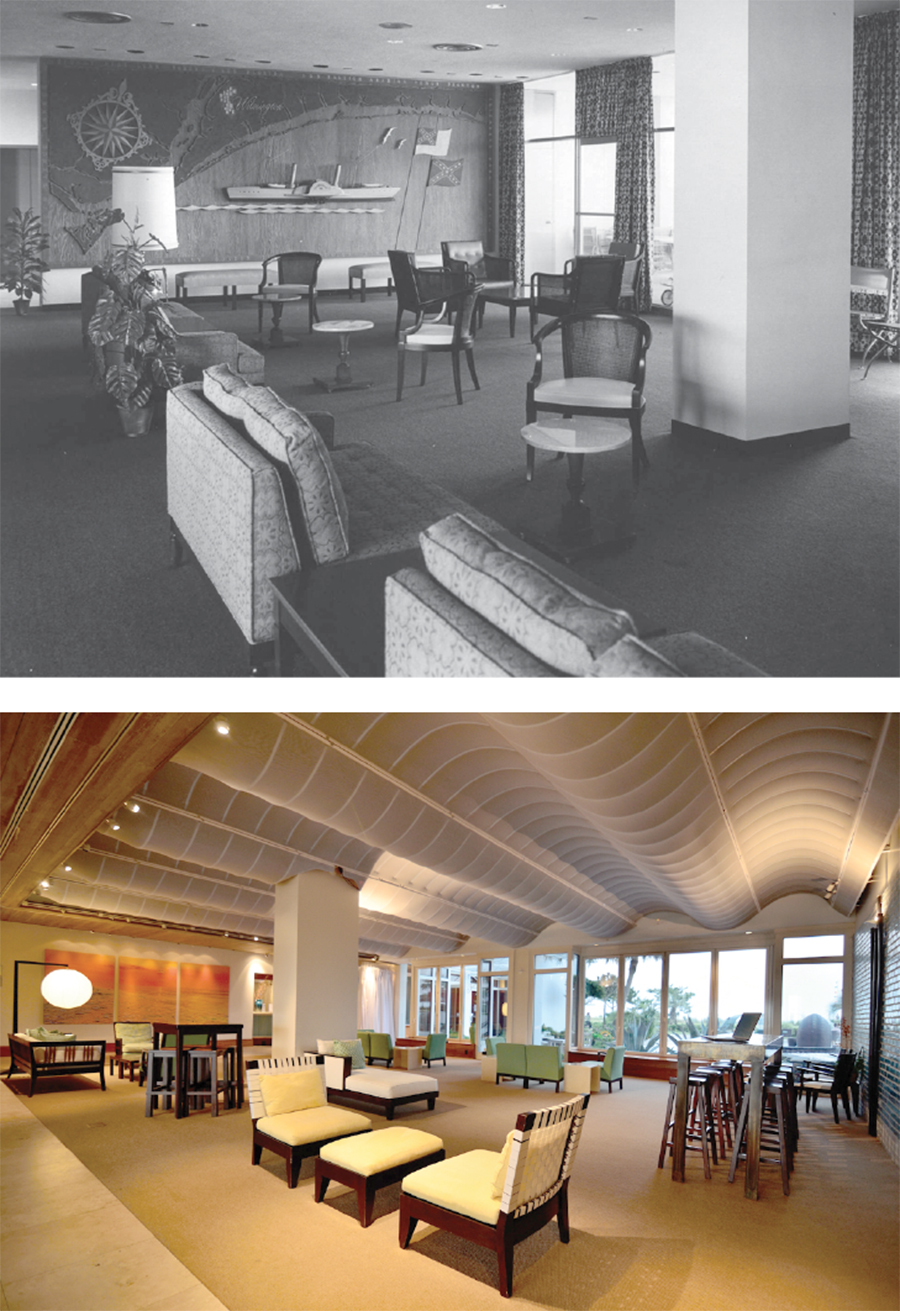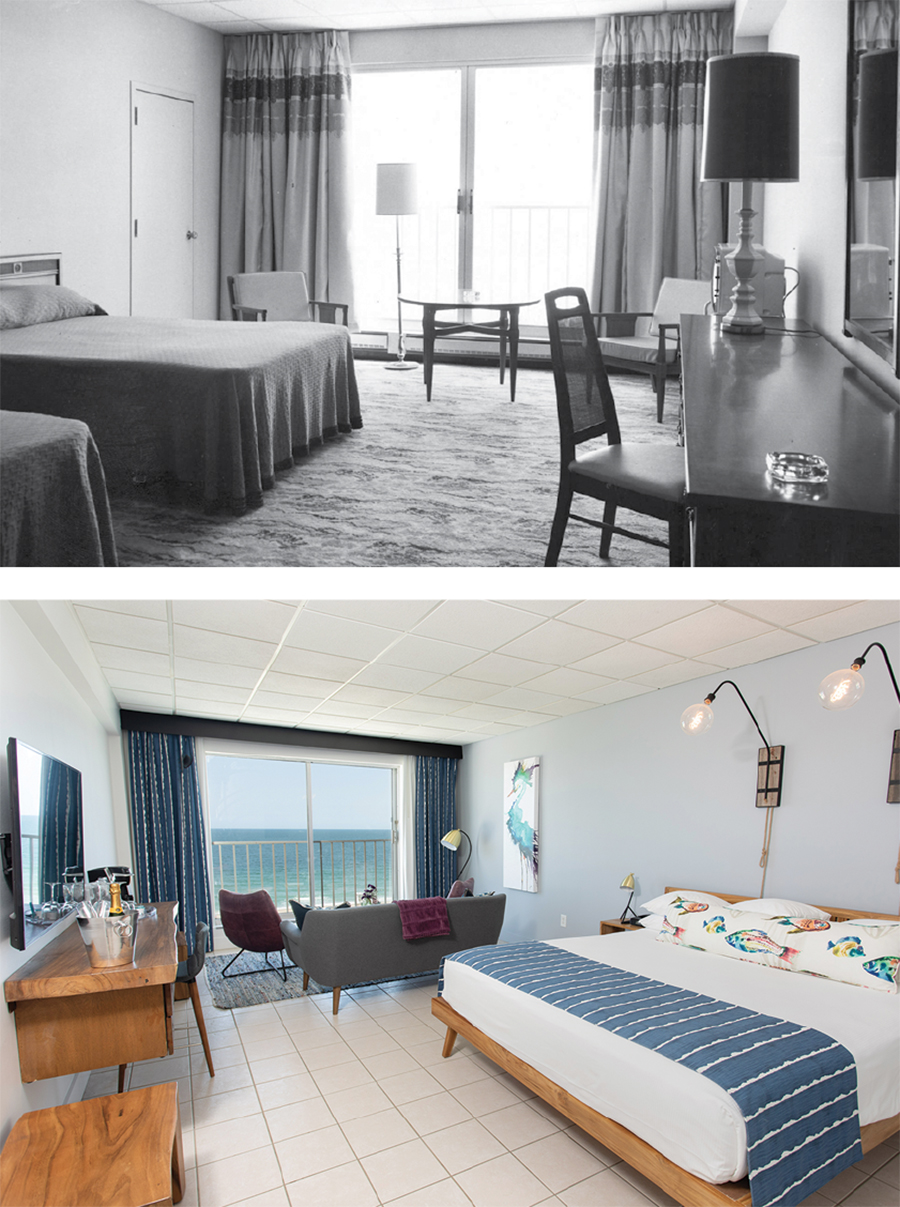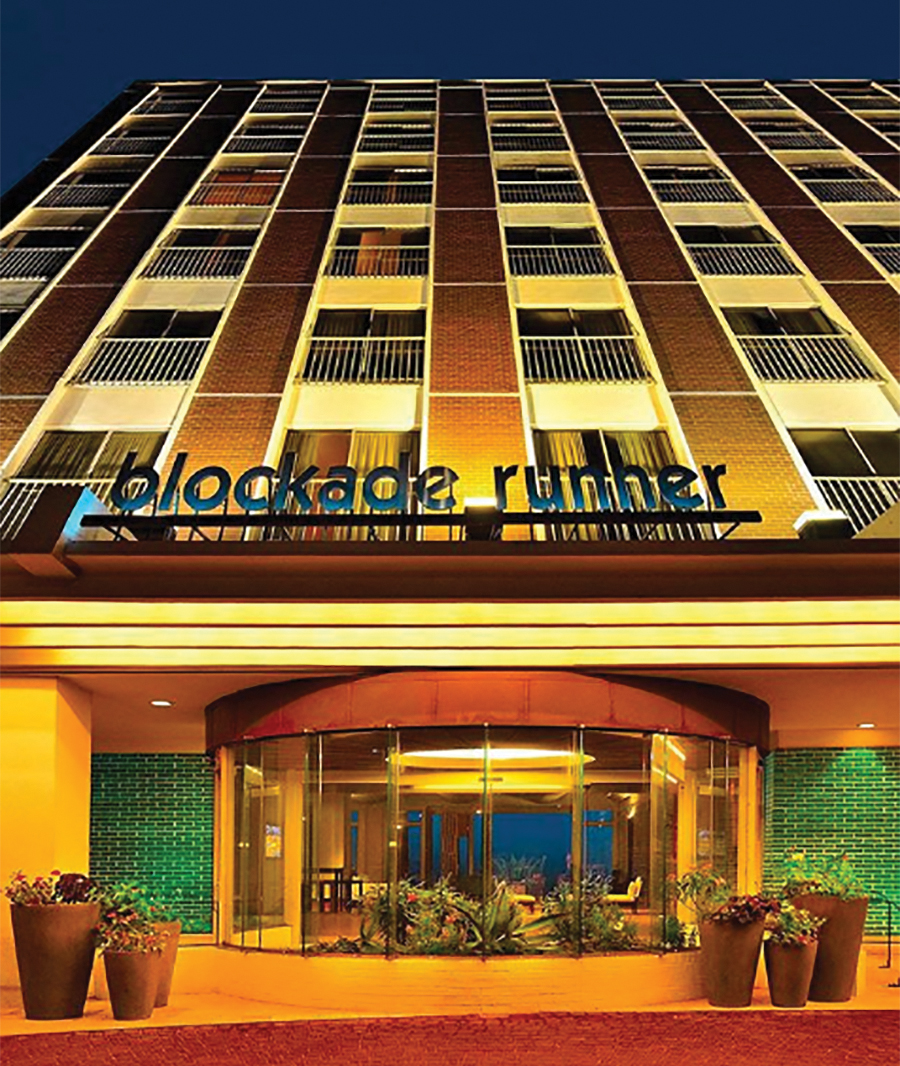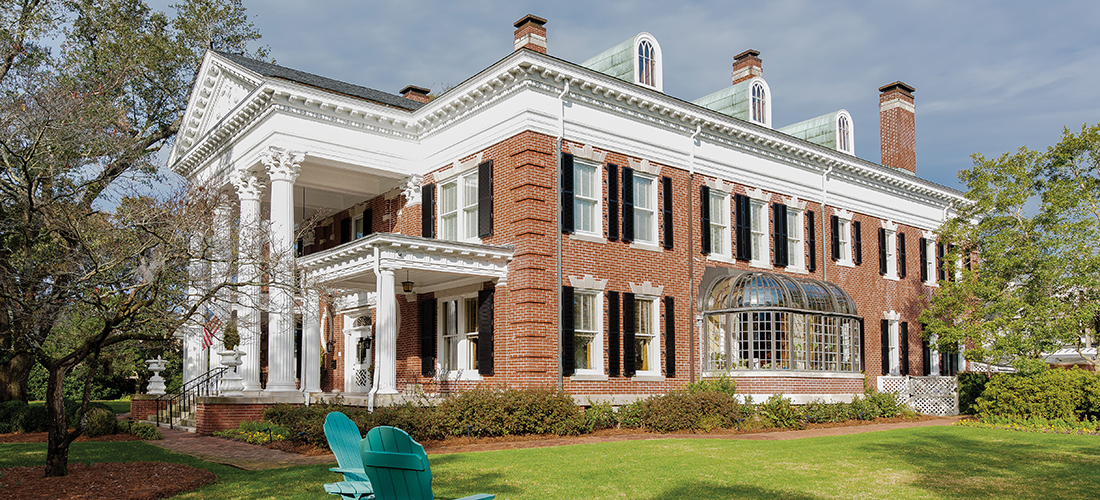Wrightsville Sound, Wrightsville Beach and the Blockade Runner Beach Resort
By Chris E. Fonvielle Jr.
The road to destruction can be swift, like a sparrow in a hurricane. The way back to recovery requires patience and perseverance. The Blockade Runner Beach Resort at Wrightsville Beach, North Carolina, has faced just such a challenge in the aftermath of Hurricane Florence that wreaked havoc on the historic oceanfront hotel in September 2018.
Reconstruction in recent years strengthened the hotel to withstand 150-mile-per-hour winds, but not Florence’s sustained 100-plus-mile winds for three days. Owners and proprietors, Bill Baggett and his sister Mary Baggett Martin and her husband, Wayne, remained at the hotel as the hurricane approached and then made landfall at Wrightsville Beach. With tongue in cheek, Mary claimed that the vicious storm targeted her family’s resort. Hunkered inside the main tower, they listened to the howling winds and then watched helplessly as the roofs peeled away like a ripe banana. “There was nothing we could do but stare in shock and awe as the roofs crashed into the front parking lot and the garden out back,” Mary commented. “We looked through the shattered ceilings from various rooms at the dark skies of the hurricane that sat on top of Wrightsville Beach for days on end.”
The Blockade Runner has survived eight hurricanes, several winter “super storms,” and gales since it opened in 1964. Mary clearly remembers Hurricane Diana in 1984, as she had just started working at the hotel that her father, Joseph W. Baggett of Lillington, North Carolina, had purchased in 1971. None of those storms, however, caused such extensive damage as Florence. Coastal storms and their impact on places like the Blockade Runner are a major part of the rich and fascinating history of Wrightsville Beach and the Lower Cape Fear.
Joshua Grainger Wright, the great-grandson of Joshua Grainger, one of the first settlers and developers of Wilmington in the 1730s, bought land and built a summer place 8 miles to the east that came to bear his surname. The village of Wrightsville emerged on what became known, by 1830, as Wrightsville Sound. Other prominent local families, including the Bradleys, Graingers, Lords and Motts, soon followed suit, acquiring property and constructing houses at Wrightsville Sound in large part to escape the heat, humidity and unhealthy environment of Wilmington during the hot months.

Wrightsville Sound encompassed a large area on the mainland from modern day Howe’s Creek south to Bradley Creek (originally called Lee’s Creek) and Hewlett’s Creek that emptied into a narrow, shallow body of water that is today the Intracoastal Waterway. From Wrightsville Sound to the Atlantic Ocean about a mile to the east stretched an expanse of sea marsh, grasslands and tidal creeks known early on as “the Hammocks.” Residents referred to the seafront’s long, sandy strip as “the Banks” but in 1855 at least, it was called Wrightsville Beach.
On June 20, 1855, the Wilmington Daily Herald advertised an auction to be conducted by Michael Cronly the following day of the hull, spars, sails, rigging, anchors and furniture from the schooner Virginia that had stranded on “Wrightsville Beach,” arguably the earliest mention of the place name on public record. To reach the auction site, interested parties took boats from the mainland through London’s Channel, the only navigable watercourse through “the Hammocks.” The channel’s namesake was John R. London, a leading landowner at Wrightsville Sound, but later renamed Grainger’s Creek.
Through most of the 19th century, Wrightsville Sound and Wrightsville Beach were the playgrounds for Wilmington’s elite. “The time is fast approaching,” wrote the editor of the Wilmington Daily Herald in June 1859, “when those of our citizens who are so fortunate as to own residences at the sound will pack up bags and baggage, retire to that place of all places, the delightful Sound, to spend the summer, away from the noise and bustle of town, free from dust and din and other objectionable features incident to city life.”
That same summer, Richard Grant opened the first documented public resort on Wrightsville Sound, near the north end of modern Summer Rest Road. There was tell of an inn near Hewlett’s Creek that catered to seamen during Colonial days, but if it existed its location has been lost to the mists of time. At Grant’s place the “weary in body and spirit [could] find quiet and repose, healthful recreation, and plenty to eat and good water to drink and bathe in.”
Ambitious tourists who ventured out to Wrightsville Beach “sea bathed,” fished, hunted and walked the strand. The Carolina Yacht Club reportedly built its headquarters “just north of Deep Inlet” in 1854, and five years later began sponsoring sailboat regattas in the sound (modern-day Banks Channel) on the east side of the beach, events that continue to this day. The regatta committee included Richard Grant and Richard Bradley, both prominent Wilmington businessmen and landowners at Wrightsville Sound.
A lack of leisure time, affordable accommodations and good transportation routes prevented working-class men and women and “middling folks” from enjoying the health and relaxation benefits of the ocean’s “salubrious breezes” along the Cape Fear coast during the summer months. Meares Road ran from Wilmington only to the headwaters of Bradley Creek, a mile west of Wrightsville Sound, while Mush Pot Road was little more than a footpath between the Topsail Sound Plank Road (near the intersection of modern Market Street and Eastwood Road) and Wrightsville.

In November 1860, William A. Wright, son of Joshua Grainger Wright, lobbied North Carolina’s General Assembly for an act of incorporation for a company to build a turnpike from the Topsail Sound Plank Road to Wrightsville Sound, but the Civil War interrupted his plans. Confederate Army units encamped at Wrightsville Sound, hoping their presence would dissuade Union troops from attempting to use Bradley or Hewlett’s Creek as avenues of attack on Wilmington from the east. Union warships that prowled the shipping lanes off Wrightsville Beach searching for Confederate commerce vessels, called blockade runners, occasionally fired artillery shells toward the camps to keep Confederate soldiers hopping. Stephen Sneeden, a commercial fisherman from Wilmington, must have worried that Yankee landing parties might damage or destroy his “fish hut” near the south end of Wrightsville Beach.
After the war, recreational activities on Wrightsville Beach became more popular. By 1885 the Carolina Yacht Club boasted 150 members who, along with their guests, could “enjoy a look at the old ocean and be fanned to their satisfaction by its health-giving breezes, to say nothing of the comfort and conveniences of a good substantial shelter.” The clubhouse, a “beautiful structure of Grecian architecture,” had to be rebuilt after its roof collapsed in a “mass of ruins” in 1877.
William A. Wright renewed his pre-war effort to build a turnpike from Wilmington to Wrightsville Sound. The Wilmington and Coast Turnpike Company received a charter from the legislature, and construction began in midsummer of 1875. The road, use of which required the payment of tolls at three booths along the route, stretched 7 1/2 miles from 17th and Dock streets to Wrightsville (modern-day Wrightsville Avenue follows the same approximate route). Paved with marl, oyster shells and limestone, locals nicknamed it the Shell Road. It opened for traffic in April 1876, but was not completed until 1880. At first, four-wheeled horse-drawn “wagonettes” transported passengers to the sound several times a day, but bicycles became a popular mode of travel during the cycling craze that began about 1885, and then automobiles after the turn of the 20th century.
The Shell Road was not the money-making venture that its stockholders had hoped, yet it did boost the development of Wrightsville and Wrightsville Sound. “The village is destined to become another Atlantic City,” claimed one impressed visitor. In July 1880, F.A. Schutte opened a resort known as Schutte’s Grove. Others soon appeared, including Seaside Park and Stokely Pavilion. In 1884, E.W. Manning and W.F. Manning opened the Pine Grove House on what is today the site of the Waterway Lodge Hotel on Wrightsville Sound. The Manning’s sharpie Mary Ann carried lodgers to Wrightsville Beach for surf fishing and moonlight excursions. “Go to Wrightsville once and you can’t stay away,” promoters boasted.
In 1887, the General Assembly chartered the Wilmington and Sea Coast Railroad. “The prime objective of building this road is to give the 21,000 population of this city a chance to spend an occasional day at the seaside,” claimed the editor of the Wilmington Morning Star. “There is a well-built shell road from the city to the sound which is the favorite drive of the wealthy, but it costs too much for a man of moderate income to go there more than once or twice a season.”

In June 1888, steam locomotives began pulling canary-colored cars loaded with tourists every two hours from downtown Wilmington to Wrightsville Sound and across a wooden trestle to the Hammocks, where the Island View Hotel and a dance pavilion had just opened. The following year, the Ocean View Railroad Company received a license to extend the Wilmington and Sea Coast Railroad from the Hammocks across Banks Channel to the beach. The public stock company also got a 20-year lease on all lands from the Hammocks, which was renamed Harbor Island in 1916, southward to Masonboro Inlet, and immediately began constructing a restaurant, bathhouses and a pavilion called the Breeze House.
The success of the Ocean View Railroad Company’s real estate projects jump-started visitation to and development of what was now being referred to as Ocean View Beach. “They have leased additional grounds on the beach and within two weeks will begin the erection of extensive buildings,” reported the Wilmington Messenger on January 31, 1890. “[The corporation] has determined to make it a popular resort.” By 1897, more than 50 cottages and several inns, including the Ocean View Hotel and the Seashore Hotel, and a hospital for children had been built near the sea. James Laurence Sprunt and the Hewlett family planned and financed much of the early construction. Incorporation of the town of Wrightsville Beach occurred on March 6, 1899.
In 1902, Hugh MacRae assumed controlling interest in both the Wilmington Sea Coast and Ocean View Railroad companies, the economic and social lifeblood of Wrightsville Sound and Wrightsville Beach. MacRae’s Consolidated Railways, Light & Power Company (renamed Tide Water Power Company) soon began developing suburban neighborhoods along the streetcar line and at Wrightsville Beach. He also converted the propulsion system of the rail cars from steam to electricity.
In 1905, MacRae built Wrightsville Beach’s grandest 20th-century attraction, the Lumina Pavilion, at Station No. 7, the last trolley stop on the beach’s south end. The Lumina featured a large ballroom for big bands and dancing, bowling alley, game arcade, athletic and aquatic competitions, beauty contests, and “moving pictures” projected onto big screens erected in the surf. It soon became the favorite destination for beachgoers and tourists. Illuminated from the roof to the ground by hundreds of tungsten lights that could be seen for miles, the Lumina became known as the “Palace of Lights.” Sadly, it was demolished in 1973 to make way for residential townhouses.
A wind-fueled fire in 1919 consumed the Seashore Hotel and the “Great Fire” of 1934 destroyed more than 100 structures on Wrightsville Beach, including the Oceanic Hotel. The Seashore Hotel was rebuilt on South Lumina Avenue, and was later renamed the Ocean Terrace Hotel. Hurricane Hazel severely damaged the Ocean Terrace in October 1954, and yet another fire burned it down two months later.

The loss of the Ocean Terrace Hotel, however, paved the way for the construction of a new seven-story-high, 120-room resort and convention center called the Blockade Runner Motor Hotel. Native Wilmingtonian Lawrence Lewis Jr. of Richmond, Virginia, bought the property and began construction of the hotel in 1962. The blockade runners that had traded at Wilmington, the Confederacy’s most important seaport by 1863, and the popularity of the Civil War Centennial prompted Lewis to name his facility the Blockade Runner Motor Hotel. The lobby originally featured a large half model of the steam blockade runner Hope and large relief map of the Lower Cape Fear during the Civil War. The Blockade Runner Motor Hotel opened with much fanfare in late March 1964.
Now known as the Blockade Runner Beach Resort, it is the longest- standing hotel on Wrightsville Beach, celebrating its 55th anniversary this year. It is unique in that the property extends from the Atlantic Ocean to Banks Channel. Bill Baggett and Mary Baggett Martin promote the Blockade Runner Beach Resort as a full-service tourist facility. They want their patrons to enjoy all the amenities they need and desire under one roof in a safe, secure and comfortable environment.
The Blockade Runner Beach Resort has expanded to 150 bedrooms and suites, and includes spacious areas for conventions, meetings and parties. In the 1980s the Blockade Runner featured the “Comedy Zone,” which brought in rising star comedians Jerry Seinfeld, Jay Leno, Ellen DeGeneres and others. Preservation North Carolina held a symposium at the Blockade Runner in March 2019. The interior has been redesigned to promote an aquatic rather than a historical theme. Today it offers patrons fine dining, live music, sailing and surfing lessons, spa and workout facilities, yoga and a freshwater pool surrounded by a beautiful flower garden. One enthusiastic employee, Sarah Wiggins, even teaches guests how to hula hoop, a big cultural fad back in the 1950s.
Mary Baggett Martin is especially proud that her family’s resort supports many local nonprofit organizations and causes. She considers herself lucky to be a longtime resident of Wrightsville Beach and the Lower Cape Fear, and revels in its blend of exceptional beauty, charm, small town feel, culture, and history. And despite Hurricane Florence’s terrible damage to the Blockade Runner, Mary is optimistic about its future: “We’ve spent the past eight months rebuilding and remodeling with the intention of making the resort better than ever.”
As locals will attest, dealing with hurricanes, gales and nor’easters is just the price you pay to live in paradise.
Dr. Fonvielle is professor emeritus in the Department of History at UNC Wilmington, and the author of articles and books on the Civil War in North Carolina and the history of the Lower Cape Fear. Upon his retirement in 2018, he was awarded the Order of the Long Leaf Pine in recognition of his distinguished service to the state of North Carolina.

